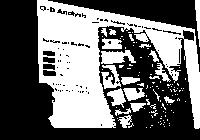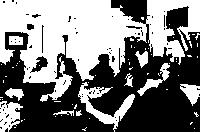 Students in last fall’s Introduction to GIS course have proven that maps can be a powerful tool for the common good.
Students in last fall’s Introduction to GIS course have proven that maps can be a powerful tool for the common good.
The students, many of whom had never used sophisticated mapping programs like ArcGIS before taking the class, recently presented their semester-long research projects to fellow students and local professionals, including land conservationists, town planners and other community officials.
From charting the effects of rising sea levels on midcoast communities to siting a communal food marketing and processing hub for farmers, the students demonstrated that they are nimble problem solvers who can take advantage of technology to improve the world around them.
Prior to the start of the semester, Prof. Eileen Johnson, Bowdoin’s Environmental Studies’ program manager and adjunct lecturer, identified several community problems for students to tackle. Students then selected their projects and consulted with local officials to hone their project focus.
The Mapping Projects
Cam Adams ’14, Hannah Glover ’13, Lisa LePage ’13 and Dan Lesser ’14 analyzed the impacts of rising sea levels in Topsham, Bowdoinham and Bath. Specifically, they looked at how sea surges, which will be driven by rising sea levels, could affect roads, buildings, access to hospitals and land values. By computing sea surges from one foot to six feet, they found that Bath would struggle at lower sea surges than its neighbors, but that Topsham and Bowdoinham would see a significant increase in damage and cost from two- and three-foot surges.
Adams said his group is hoping to present its findings at a town forum in the spring for officials and residents as part of a larger readiness initiative. The map is intended to “encourage the development of resilient shorelines”¦that are prepared for rising sea levels and stronger storms,” according to the students.
Matt Frongillo ’13, Jay Tulchin ’13 and Jack Mensik ’14 worked with Local Farms-Local Food to find the best location for a food hub. A food hub is a centralized location where farmers can take their produce to clean, package or freeze for sale – in other words, “to facilitate the production of local food,” Mensik said.
The three students created a map of local farms and analyzed the road network to find the most convenient location for the most farmers. They situated their hypothetical facility in Bowdoinham, arguing that the central spot’s proximity to major roads would minimize travel distance and thus would maximize use.
At the request of Brunswick officials, Alex Thompson ’13 and Sam Vitello ’13 evaluated the current availability of downtown parking. The town is working with business owners to identify additional public and private lots already in place to begin asking owners for permission to use their lots. “To try to figure out what parking is there that the town could possibly make use of, we categorized and geocoded and digitized all the private parking lots in the downtown,” Vitello said. This was a first for the town as private parking had never been tallied in the past.
By using Walmart’s parking lot dimensions to estimate the distance people might be willing to walk from their parked cars to stores and restaurants, the two students highlighted the most valuable private parking spots on their map. “If private owners allow their parking to be shared at different times of the day, it [certainly] increases the amount of available parking,” Vitello pointed out.
For the Kennebec Land Trust, Gabriela Serrato Marks ’15 and Stephanie Lynn ’14 identified tracts of land that have conservation value in the towns of Sidney and Readfield.
Both Emma Cutler ’13 and Brian Jacobel ’14 looked at the watershed of an impaired stream in Topsham that the town is trying to protect. Cutler, who studied the development history of the commercial mall close to the stream, said her data could help town planners decide whether they should implement size limits on parking lots. Jacobel analyzed whether mapping tools could help planners more quickly determine the area of impervious surfaces.
Other students looked beyond Maine and expanded their mapping projects by turning them into honor’s projects. Charlie Cubeta ’13 studied the influence of industry on neighborhood vacancy rates in Detroit, Mich. Ben Richmond ’13 identified the best wind-turbine sites in Franklin County. Gordon Adams ’14 studied the relationship between land cover and the water chemistry of the Androscoggin, Kennebec, Penobscot and St. John rivers. And Jimmy Rohman ’13 looked at the impact of rising sea levels on Fort Lauderdale, Florida.
һӻ














